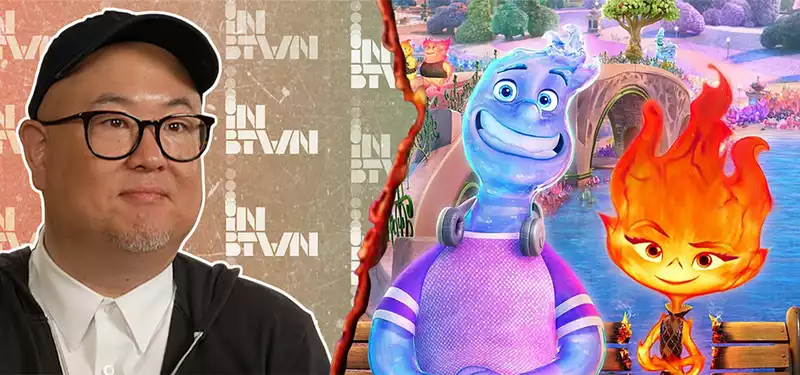Jun 23, 2023
Peter Thorne explains how "Elemental" evolved from a superhero vs. villain story to something more personal (video interview)
Director Peter Thorne has done just about everything possible in his 23 years at Pixar. His latest project is directing "Elemental," now in theaters. [Last week, the film had a special screening in Annecy, and IBTWN Animation, in collaboration with Cartoon Brew, sat down with Thorne to talk about one of the most personal projects he has ever worked on.
Narratively, the "seed" of "Elemental" came from his own upbringing as a child of Korean immigrants living in New York City. But seeds do not grow by themselves. So Song interviewed hundreds of people at Pixar with immigrant stories to give him the elements he needed for his seed to grow.
"That (idea) started to resonate with artists from different departments and they started bringing their own stories. I love that it started as this personal seed and from there other stories grew and became all of us," he said.
As the film's development progressed, the story changed several significant times. Thorne knew what kind of story he wanted to tell, but he still had to work out the specifics. Early versions of the film featured a villain, but according to Thorne, that would have essentially made it another superhero movie, and that was not the kind of story his team was trying to tell.
"Every time we started an abstract story, Pixar audiences found that the characters were abstract, and once the story became abstract, nothing really grabbed them. 'So we had to find something grounded. Some of its early versions were basically more like superhero movies, using the power of fire and water to stop the villain. But we didn't feel anything. So we were looking for a connection to the elements."
[10In his search for connection, Thorne recalls seeing concept art in which amber is represented as a candle flame that becomes smaller when it feels vulnerable." He recalled that "when you are with someone and you are emotionally naked, if they say something negative, you will just be crushed.
From there it became about the visual metaphor between elemental action and human emotion. It was something that felt real against a villain taking over a city in a clichéd way."
Thorne had an idea, but needed a way to visualize it in an animated way. The roots of using anthropomorphic elements as characters to tell a story came from Thorne's childhood.
"When I first saw the periodic table of elements in school, I saw them as a collection of houses, and I drew characters. There were jokes like, 'Copper lives next to helium, but watch out for the gas. But that was it, there was nothing else."
The film unfolds as a romantic comedy about two young elements, Amber and Wade, who live in a city where fire, water, land, and air inhabitants coexist. The film's major themes are based on Thorne's own upbringing as the child of immigrants in New York City.
It is one thing to have the idea of personifying the four classical elements as characters, and quite another to bring it to life on the screen. Thorne said it took a little naivete, a lot of determination, and the help of many people at Pixar to make it happen.
"There was a lot of fear and a lot of advice about what would be at stake," he recalled of the initial pitch to use the elements as characters.
"I was very reluctant to do it because I couldn't find an example of such a character outside of a 2D drawing, like Calcifer in Howl's Moving Castle."
Son said that one of the biggest challenges in using elemental characters was that "we wanted them to express their emotions in a human way, but they couldn't be human in terms of their skeleton."
"It all started with the drawing, and then it was years of experimentation. There was no path." Citing characters from "Toy Story" and "Cars," he explained that Referring to the characters in "Toy Story" and "Cars," he said.
Pixar recently published several detailed technical papers on how it achieved some of the film's special effects, and many of the technical staff who made it possible will be speaking at upcoming industry events. Son believes, however, that the average moviegoer will probably never fully understand just how much went into making that impressive image possible.
"When you look at it, you think, 'Oh, they just put something on.' But we spent years in that studio trying to build the road, and a lot of people worked really hard to see if they could control the flames. A lot of it was trying to control it slowly so the audience wouldn't say, 'Oh, this isn't fire anymore,'" he says.
And just as it was difficult to figure out how to make a character made of fire, it took a lot more work to make the film's water characters work on screen. Slow down the bubbles, and he turns to jelly. Turn off the highlights and he becomes a ghost."
For more insight into the making of the film, check out the entire INBTWN interview linked above.
.



Post your comment